Evaluation of the Rheological and Durability Performance of Sustainable Self-Compacting Concrete
Abstract
:1. Introduction
2. Materials and Mix Proportion
2.1. Materials
2.1.1. Supplementary Cementitious Materials
2.1.2. Filler Materials
2.2. SCC Mix Proportioning
2.3. Test Procedure
2.3.1. SCC Fresh Properties
2.3.2. SCC Durability Properties
3. Experimental Investigation
3.1. Compressive Strength
3.2. Water Absorption
3.3. Sorptivity
3.4. Chemical Attacks (Chloride Attack, Sulphate Attack, Sulphuric Attack, and Nitric Attack)
3.5. RCPT (Rapid Chloride Permeability Test)
3.6. Elevated Temperature Test on SCC Specimens
4. Experimental Results
4.1. Compressive Strength Test on SCC
4.2. Water Absorption and Sorptivity
4.3. Sulphuric and Nitric Acid Test
4.4. Sulphate and Chloride Attack Test
4.5. RCPT (Rapid Chloride Permeability Test)
4.6. Compressive Strength and Mass Loss of SCC Exposed to Elevated Temperatures
4.6.1. Residual Compressive Strength of SCC
4.6.2. Mass Loss
4.7. Physical Observations (Chemical Attack on Specimens)
5. Sustainable Approach
5.1. Cost Analysis
5.2. Energy Efficiency
5.3. CO2 Emission Efficiency
6. Conclusions
- The Ground Granulated Blast Furnace Slag (GGBFS) specimen exhibits higher compressive strength than the reference, Fly Ash (FA), and Expanded Perlite Aggregate (EPA) specimens. Furthermore, when the curing age increases, Self-Compacting Concrete (SCC) strength property rises dramatically. As a result, the early-age strength increase is higher in the GGBFS-based SCC mix than in the FA-based SCC mix. The water absorption and sorptivity results found that the surface moisture absorption of SCC with GGBFS exhibits slightly higher values than other specimens (FA, FA/EPA, and GGBFS/EPA).
- Both H2SO4 and HNO3 acids highly affect the weight and strength properties of all SCC specimens. From the experimental results, it is found that the residual compressive strength of H2SO4 concrete specimens is 20.1% (FA), 9.3% (FA/EPA), 27.4% (GGBFS), and 17.14% (GGBFS/EPA). Similar variation was noted in the nitric attack specimens, and the residual compressive strength values are 51.5% (FA), 40% (FA/EPA), 54% (GGBFS), and 49% (GGBFS/EPA), respectively.
- All SCC specimens with chloride penetration perform better for up to 90 days. It was due to the chloride ions being significantly enhanced by the pozzolanic activity provided by FA and GGBFS.
- The same SCC specimen exhibits a more significant mass loss reduction in strength at 60 and 120 min of exposure to fire, such as 16–63% for (FA/EPA, FA, GGBFS/EPA, and GGBFS).
- Based on the sustainable analysis, SCC’s cost, CO2, and energy efficiency were significantly less than the Ordinary Portland Cement (OPC) mix. Therefore, the developed SCC is highly recommended for the cast in-site and precast construction without any economic and environmental effects.
Author Contributions
Funding
Data Availability Statement
Conflicts of Interest
References
- Kanagaraj, B.; Kiran, T.; Anand, N.; Al Jabri, K.; Justin, S. Development and Strength Assessment of Eco-Friendly Geopolymer Concrete Made with Natural and Recycled Aggregates. Constr. Innov. 2022. [Google Scholar] [CrossRef]
- Ealiyas Mathews, M.; Anand, N.; Prince Arulraj, G.; Kiran, T. Rheological and Mechanical Characterization of Self-Compacting Concrete with Utilization of Supplementary Sustainable Cementitious Materials. In IOP Conference Series: Earth and Environmental Science; IOP Publishing: Bristol, UK, 2020; Volume 491. [Google Scholar]
- Kiran, T.; Mathews, M.E.; Anand, N.; Alengaram, U.J.; Andrushia, A.D. Influence of Mineral Admixtures on the Residual Mechanical Properties and Durability Characteristics of Self-Compacting Concrete Subjected to High Temperature. Aust. J. Civ. Eng. 2021, 20, 244–260. [Google Scholar] [CrossRef]
- Nandhini, K.; Ponmalar, V. Effect of Blending Micro and Nano Silica on the Mechanical and Durability Properties of Self-Compacting Concrete. Silicon 2021, 13, 687–695. [Google Scholar] [CrossRef]
- Anand, N.; Arulraj, G.P. Effect of Grade of Concrete on the Performance of Self-Compacting Concrete Beams Subjected to Elevated Temperatures. Fire Technol. 2014, 50, 1269–1284. [Google Scholar] [CrossRef]
- Antony Godwin, I.; Anand, N.; Prince Arulraj, G.; Aravindhan, C. Influence of Mineral Admixture on Stress Strain Behaviour of Self Compacting Concrete under Elevated Temperature. Indian J. Sci. Technol. 2016, 9, 6. [Google Scholar] [CrossRef] [Green Version]
- Mohammed, A.M.; Asaad, D.S.; Al-Hadithi, A.I. Experimental and Statistical Evaluation of Rheological Properties of Self-Compacting Concrete Containing Fly Ash and Ground Granulated Blast Furnace Slag. J. King Saud Univ. Eng. Sci. 2022, 34, 388–397. [Google Scholar] [CrossRef]
- Ma, B.; Wang, H. Rheological Properties of Self-Compacting Concrete Paste Containing Chemical Admixtures. J. Wuhan Univ. Technol. Mater. Sci. Ed. 2013, 28, 291–297. [Google Scholar] [CrossRef]
- Mathews, M.E.; Anand, N.; Lublóy, É.; Kiran, T. Effect of Elevated Temperature on Interfacial Shear Transfer Capacity of Self-Compacting Concrete. Case Stud. Constr. Mater. 2021, 15, e00753. [Google Scholar] [CrossRef]
- Kwan, A.K.H.; Ling, S.K. Lowering Paste Volume of SCC through Aggregate Proportioning to Reduce Carbon Footprint. Constr. Build. Mater. 2015, 93, 584–594. [Google Scholar] [CrossRef]
- Dinakar, P.; Babu, K.G.; Santhanam, M. Durability Properties of High Volume Fly Ash Self Compacting Concretes. Cem. Concr. Compos. 2008, 30, 880–886. [Google Scholar] [CrossRef]
- Mohan, A.; Mini, K.M. Strength and Durability Studies of SCC Incorporating Silica Fume and Ultra Fine GGBS. Constr. Build. Mater. 2018, 171, 919–928. [Google Scholar] [CrossRef]
- Esquinas, A.R.; Motos-Pérez, D.; Jiménez, M.E.; Ramos, C.; Jiménez, J.R.; Fernández, J.M. Mechanical and Durability Behaviour of Self-Compacting Concretes for Application in the Manufacture of Hazardous Waste Containers. Constr. Build. Mater. 2018, 168, 442–458. [Google Scholar] [CrossRef]
- Kiran, T.; Anand, N.; Nitish Kumar, S.; Andrushia, D.; Singh, S.K.; Arulraj, P. Influence of Nano-Cementitious Materials on Improving the Corrosion Resistance and Microstructure Characteristics of Concrete. J. Adhes. Sci. Technol. 2021, 35, 1995–2022. [Google Scholar] [CrossRef]
- Sharma, R.; Khan, R.A. Durability Assessment of Self Compacting Concrete Incorporating Copper Slag as Fine Aggregates. Constr. Build. Mater. 2017, 155, 617–629. [Google Scholar] [CrossRef]
- Kanadasan, J.; Abdul Razak, H. Engineering and Sustainability Performance of Self-Compacting Palm Oil Mill Incinerated Waste Concrete. J. Clean. Prod. 2015, 89, 78–86. [Google Scholar] [CrossRef] [Green Version]
- Esquinas, A.R.; Álvarez, J.I.; Jiménez, J.R.; Fernández, J.M. Durability of Self-Compacting Concrete Made from Non-Conforming Fly Ash from Coal-Fired Power Plants. Constr. Build. Mater. 2018, 189, 993–1006. [Google Scholar] [CrossRef]
- IS:12269-2013; Ordinary Portland Cement, 53 Grade Specification (First Revision). Bureau of Indian Standards: New Delhi, India, 2013.
- IS 383:1970; Specification for Coarse and Fine Aggregates from Natural Sources for Concrete. Bureau of Indian Standards: New Delhi, India, 1970.
- IS 516:2014; Method of Tests for Strength of Concrete. Bureau of Indian Standards: New Delhi, India, 2004.
- ASTM C1585-04; Standard Test Method for Measurement of Rate of Absorption of Water by Hydraulic-Cement Concretes. American Society for Testing and Materials International: West Conshohocken, PA, USA, 2004; Volume i, pp. 1–6.
- ASTM C1202; Standard Test Method for Electrical Indication of Concrete’s Ability to Resist Chloride Ion Penetration. American society for Testing and Materials International: West Conshohocken, PA, USA, 2012.
- ISO 834-1999; Fire Resistance Tests—Elements of Building Construction. International Organization for Standardization: Geneva, Switzerland, 1999; Volume 1999, p. 53.
- Dinakar, P.; Kartik Reddy, M.; Sharma, M. Behaviour of Self Compacting Concrete Using Portland Pozzolana Cement with Different Levels of Fly Ash. Mater. Des. 2013, 46, 609–616. [Google Scholar] [CrossRef]
- Amin, M.N.; Javed, M.F.; Khan, K.; Shalabi, F.I.; Qadir, M.G. Modeling Compressive Strength of Eco-Friendly Volcanic Ash Mortar Using Artificial Neural Networking. Symmetry 2021, 13, 2009. [Google Scholar] [CrossRef]
- El Mir, A.; Nehme, S.G. Utilization of Industrial Waste Perlite Powder in Self-Compacting Concrete. J. Clean. Prod. 2017, 156, 507–517. [Google Scholar] [CrossRef]
- Nuruzzaman, M.; Kuri, J.C.; Sarker, P.K. Strength, Permeability and Microstructure of Self-Compacting Concrete with the Dual Use of Ferronickel Slag as Fine Aggregate and Supplementary Binder. Constr. Build. Mater. 2022, 318, 125927. [Google Scholar] [CrossRef]
- Islam, G.M.S.; Akter, S.; Reza, T.B. Sustainable High-Performance, Self-Compacting Concrete Using Ladle Slag. Clean. Eng. Technol. 2022, 7, 100439. [Google Scholar] [CrossRef]
- Mathews, M.E.; Kiran, T.; Hasa Naidu, V.C.; Jeyakumar, G.; Anand, N. Effect of High-Temperature on the Mechanical and Durability Behaviour of Concrete. Mater. Today Proc. 2020, 42, 718–725. [Google Scholar] [CrossRef]
- Nazari, A.; Riahi, S. Effects of Al2O3 Nanoparticles on Properties of Self Compacting Concrete with Ground Granulated Blast Furnace Slag (GGBFS) as Binder. Sci. China Technol. Sci. 2011, 54, 2327–2338. [Google Scholar] [CrossRef]
- Sharma, R.; Khan, R.A. Influence of Copper Slag and Metakaolin on the Durability of Self Compacting Concrete. J. Clean. Prod. 2018, 171, 1171–1186. [Google Scholar] [CrossRef]
- Sandhu, R.K.; Siddique, R. Properties of Sustainable Self-Compacting Concrete Made with Rice Husk Ash. Eur. J. Environ. Civ. Eng. 2022, 26, 6670–6694. [Google Scholar] [CrossRef]
- Mathews, M.E.; Anand, N.; Kodur, V.K.R.; Arulraj, G.P. Investigation on Bond Strength of Self-Compacting Concrete Exposed to Elevated Temperature. Proc. Inst. Civ. Eng.—Struct. Build. 2021, 174, 804–821. [Google Scholar] [CrossRef]
- IS 10262; Concrete Mix Proportioning—Guidelines. Bureau of Indian Standards: New Delhi, India, 2009.
- Alsalman, A.; Assi, L.N.; Kareem, R.S.; Carter, K.; Ziehl, P. Energy and CO2 Emission Assessments of Alkali-Activated Concrete and Ordinary Portland Cement Concrete: A Comparative Analysis of Different Grades of Concrete. Clean. Environ. Syst. 2021, 3, 100047. [Google Scholar] [CrossRef]
- Flower, D.J.M.; Sanjayan, J.G. Green House Gas Emissions due to Concrete Manufacture. Int. J. Life Cycle Assess. 2007, 12, 282–288. [Google Scholar] [CrossRef]
- Hills, T.; Florin, N.; Fennell, P.S. Decarbonising the Cement Sector: A Bottom-up Model for Optimising Carbon Capture Application in the UK. J. Clean. Prod. 2016, 139, 1351–1361. [Google Scholar] [CrossRef]
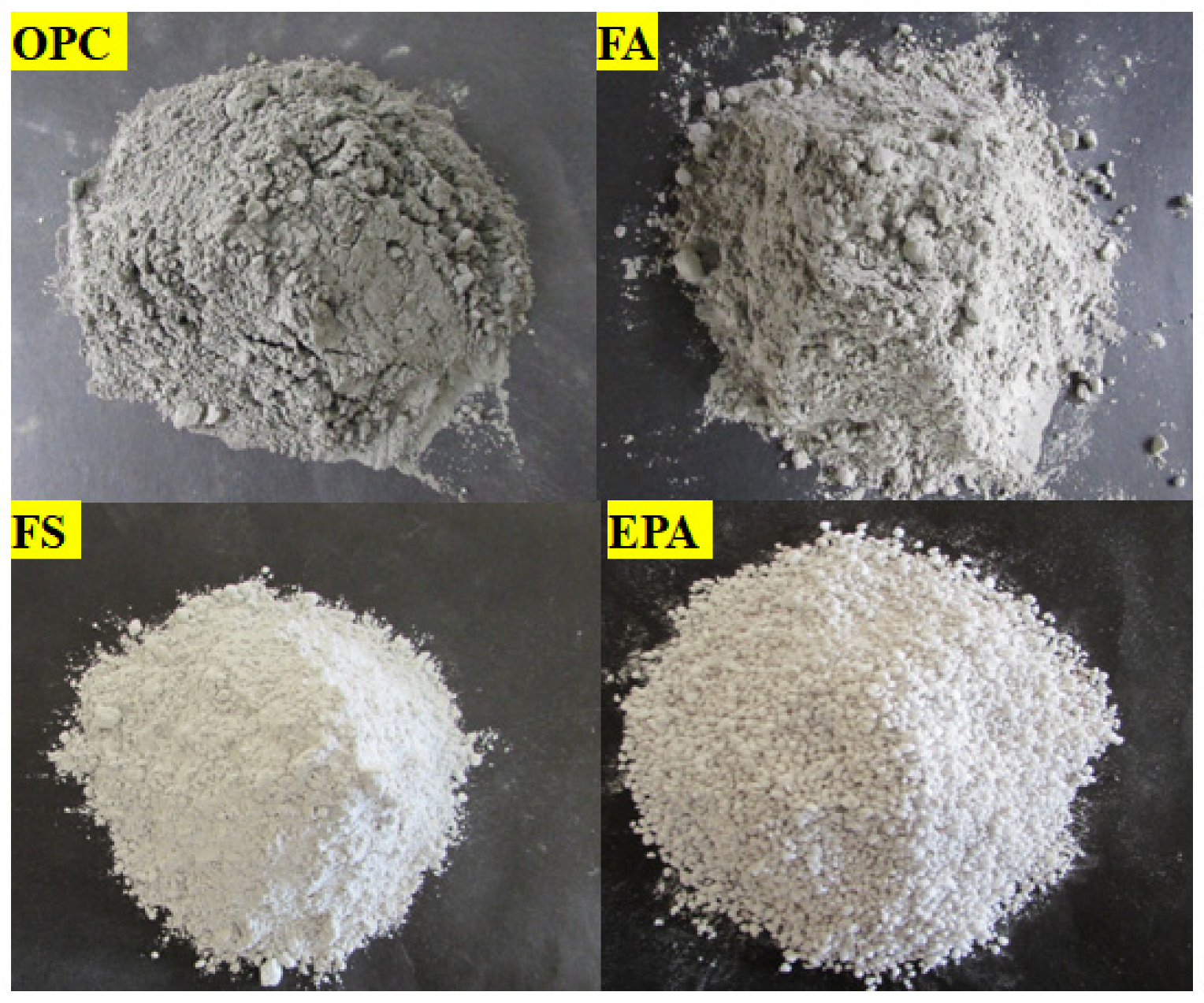
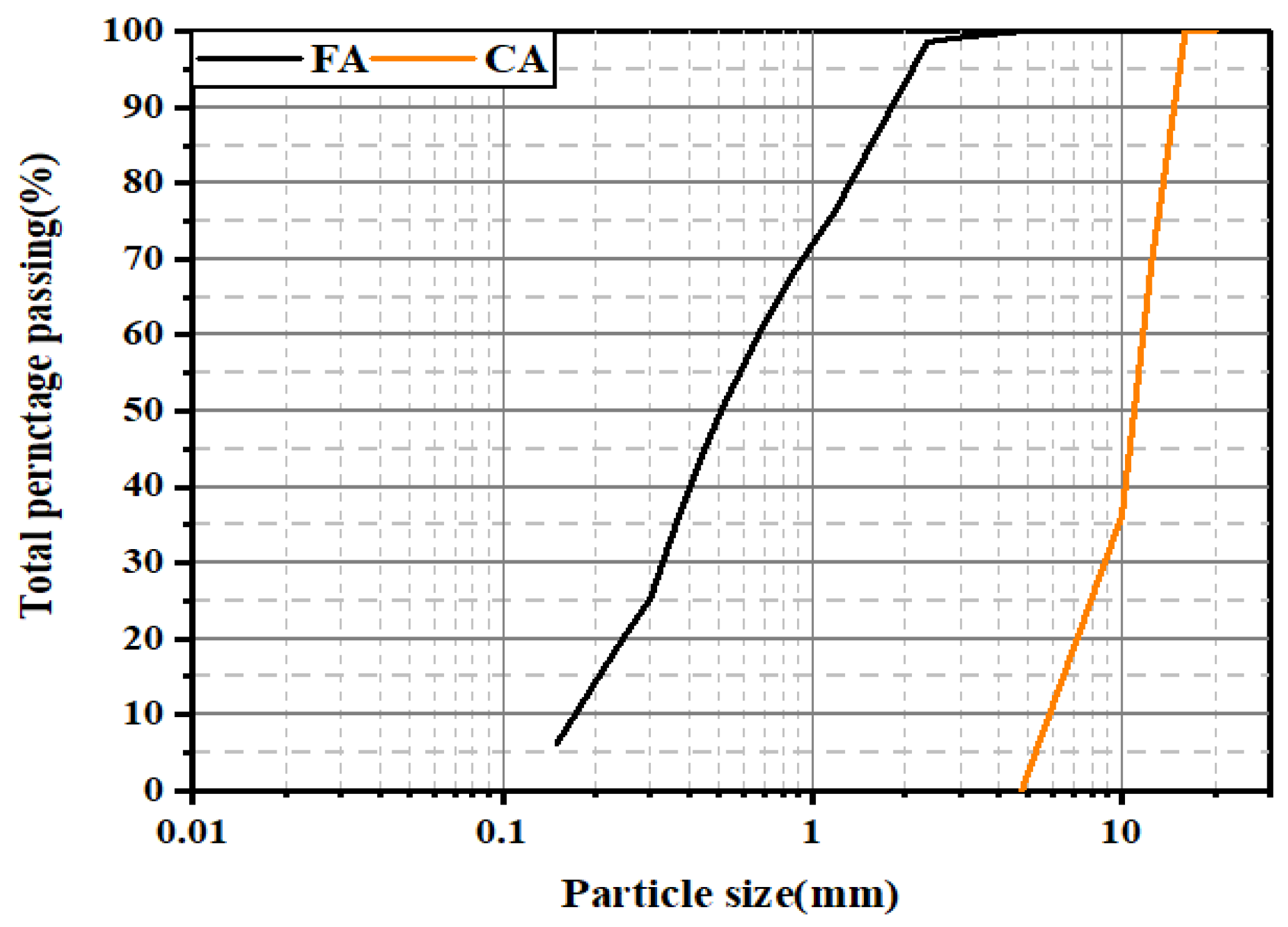
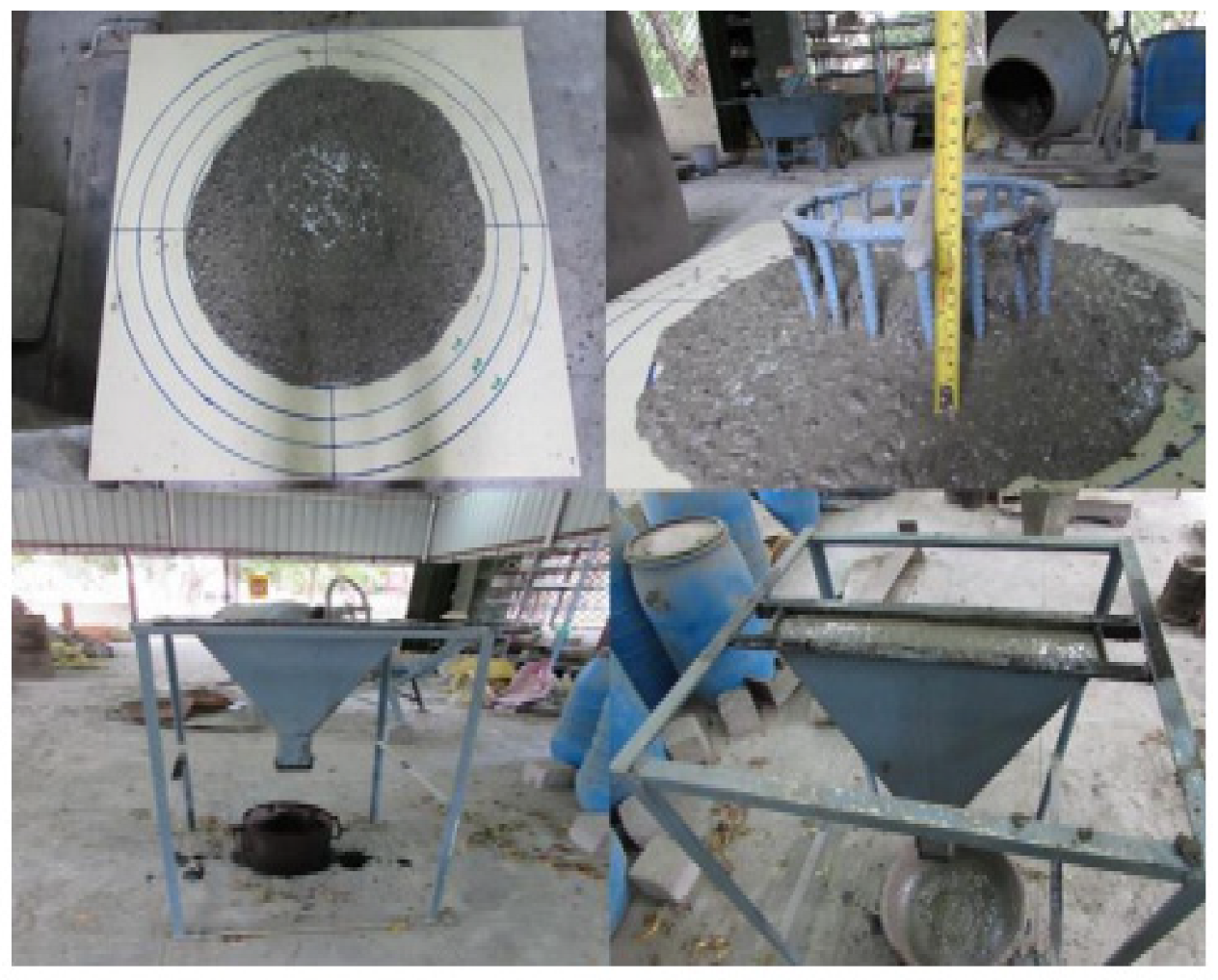
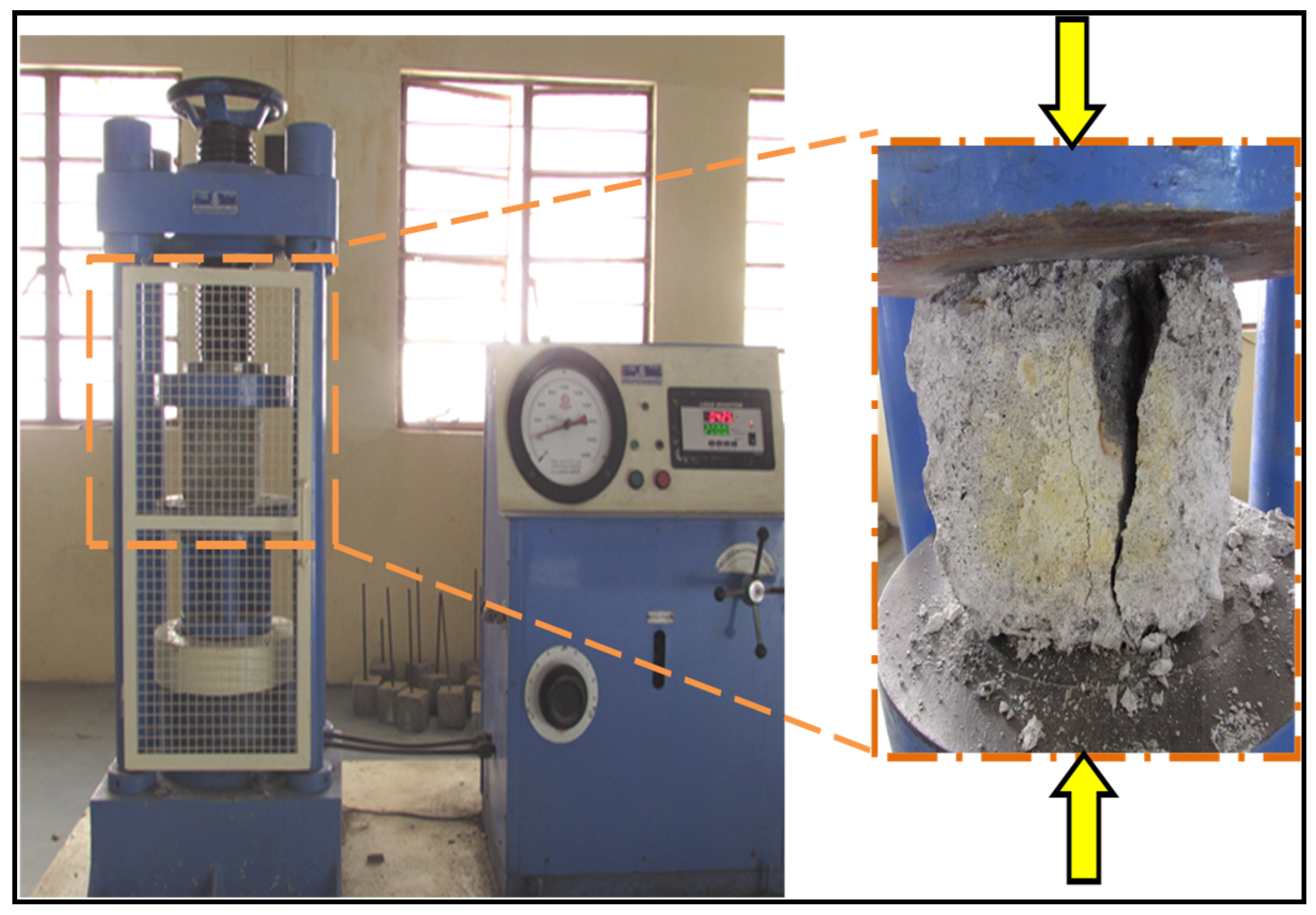

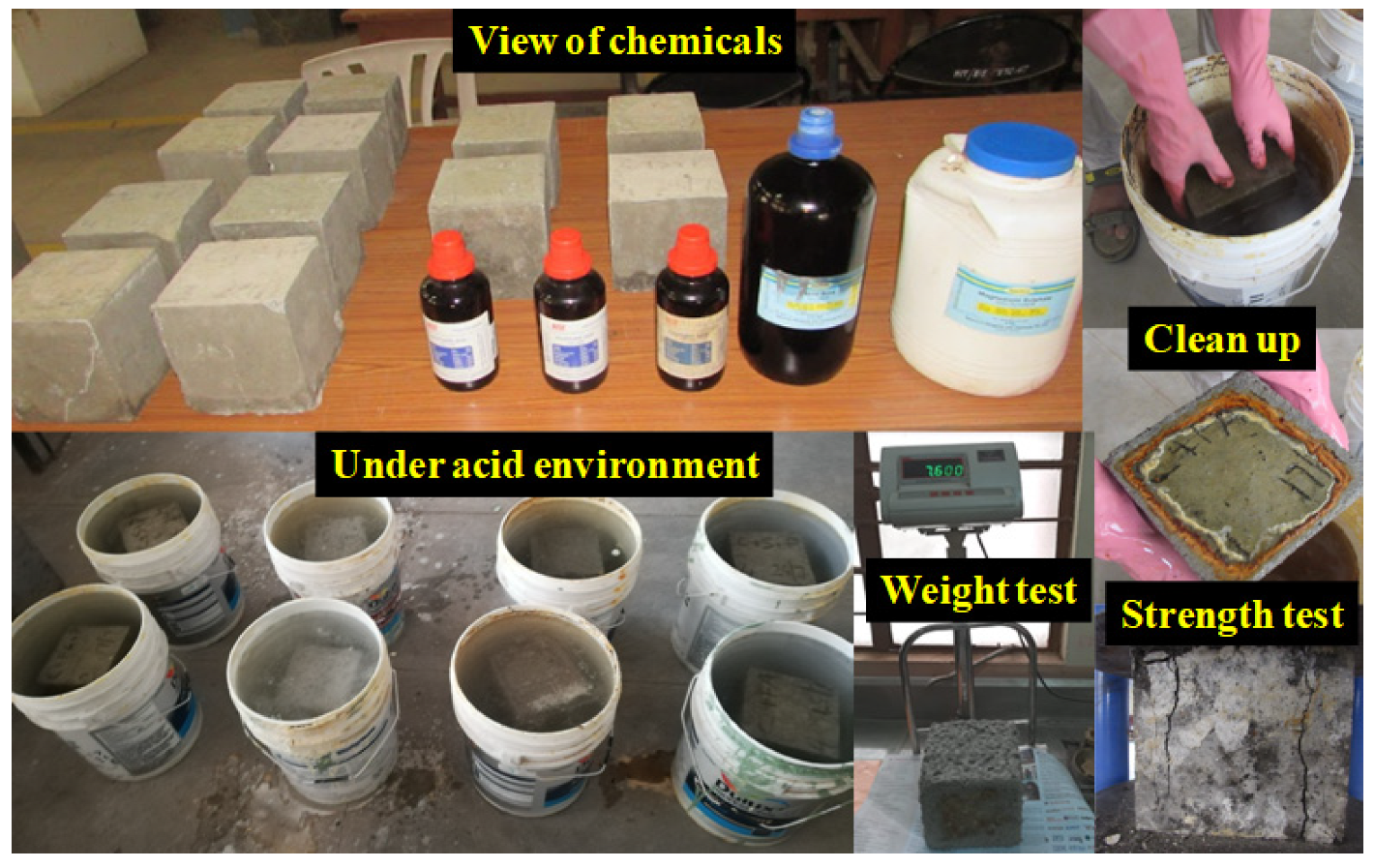
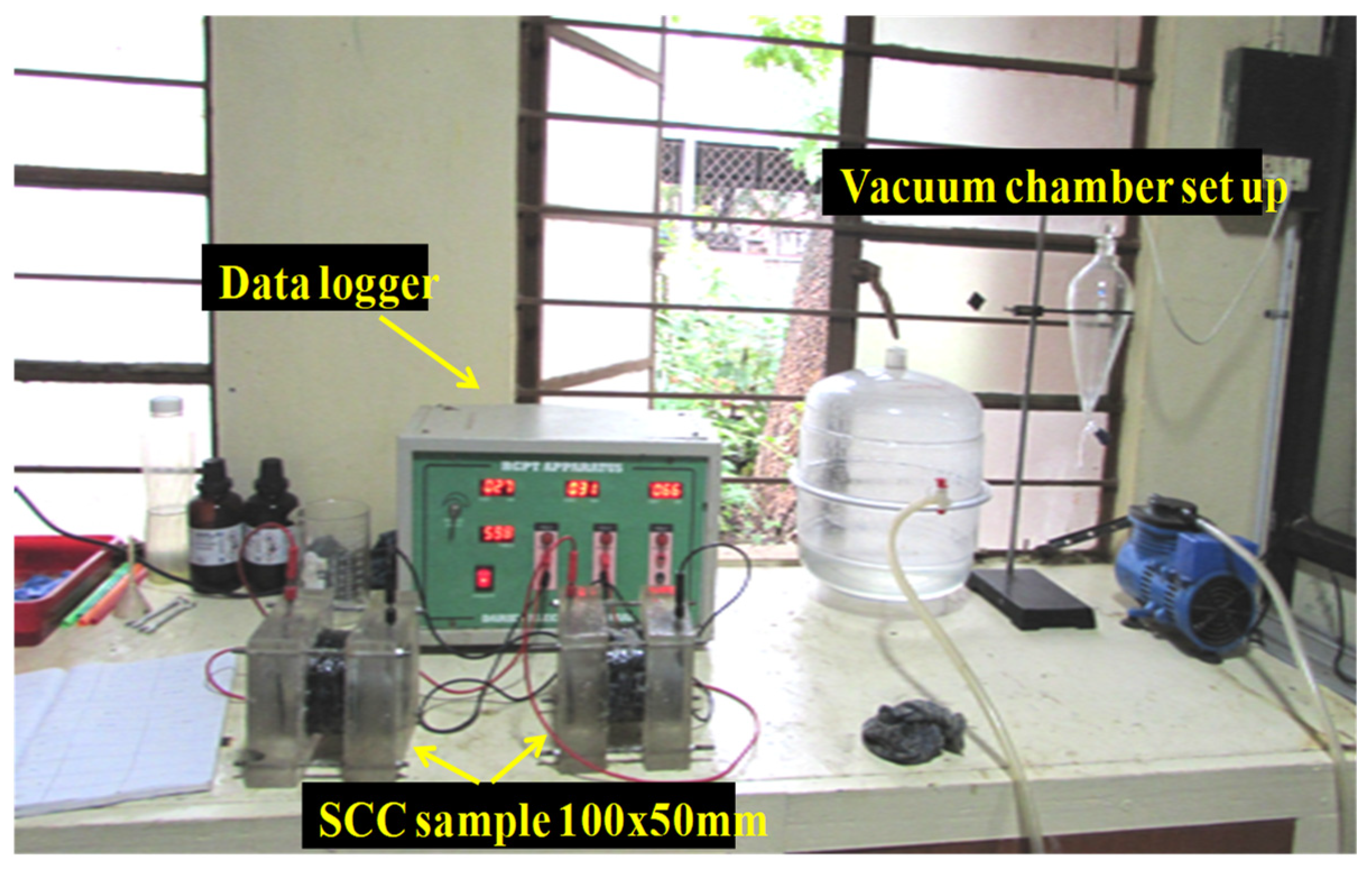

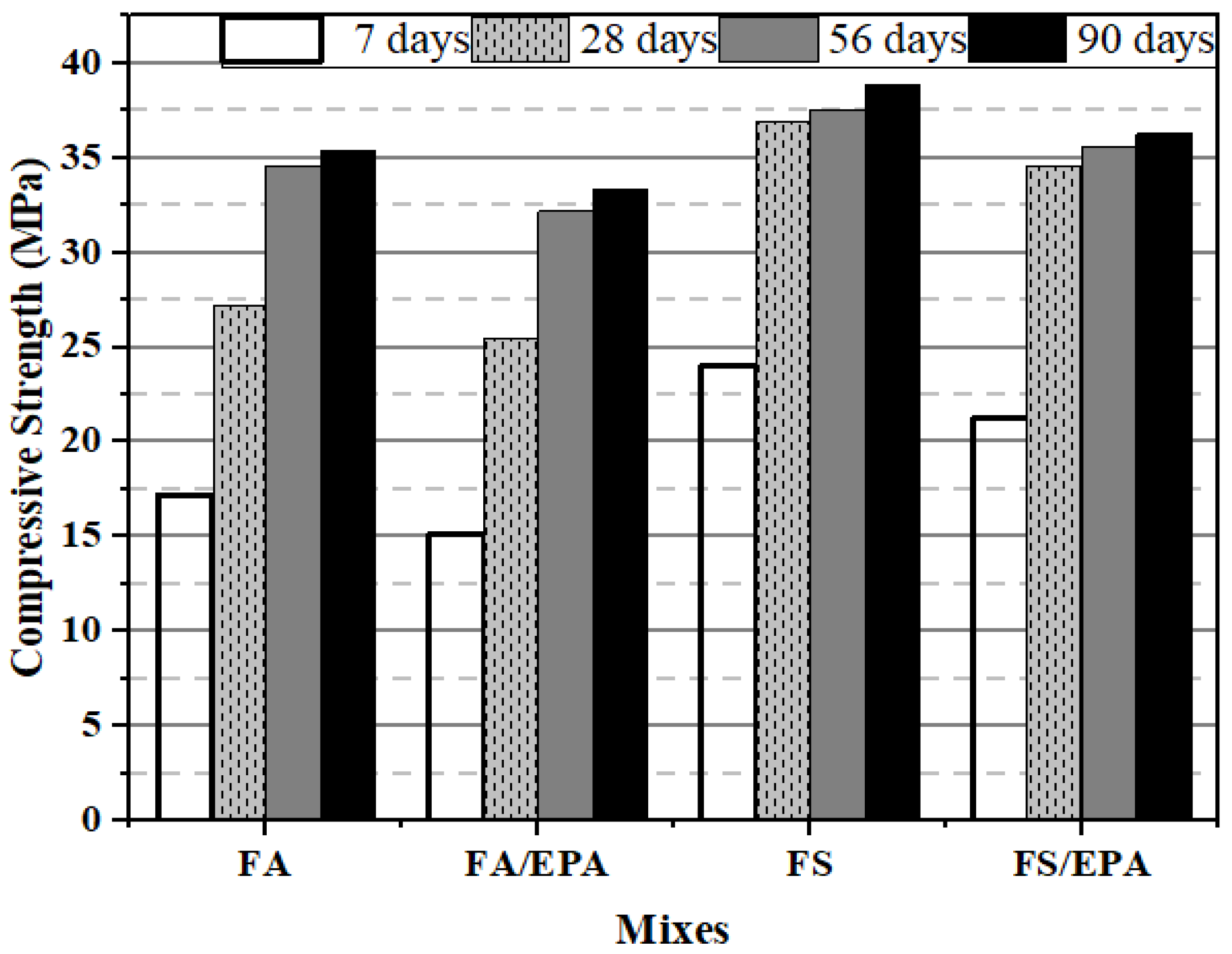
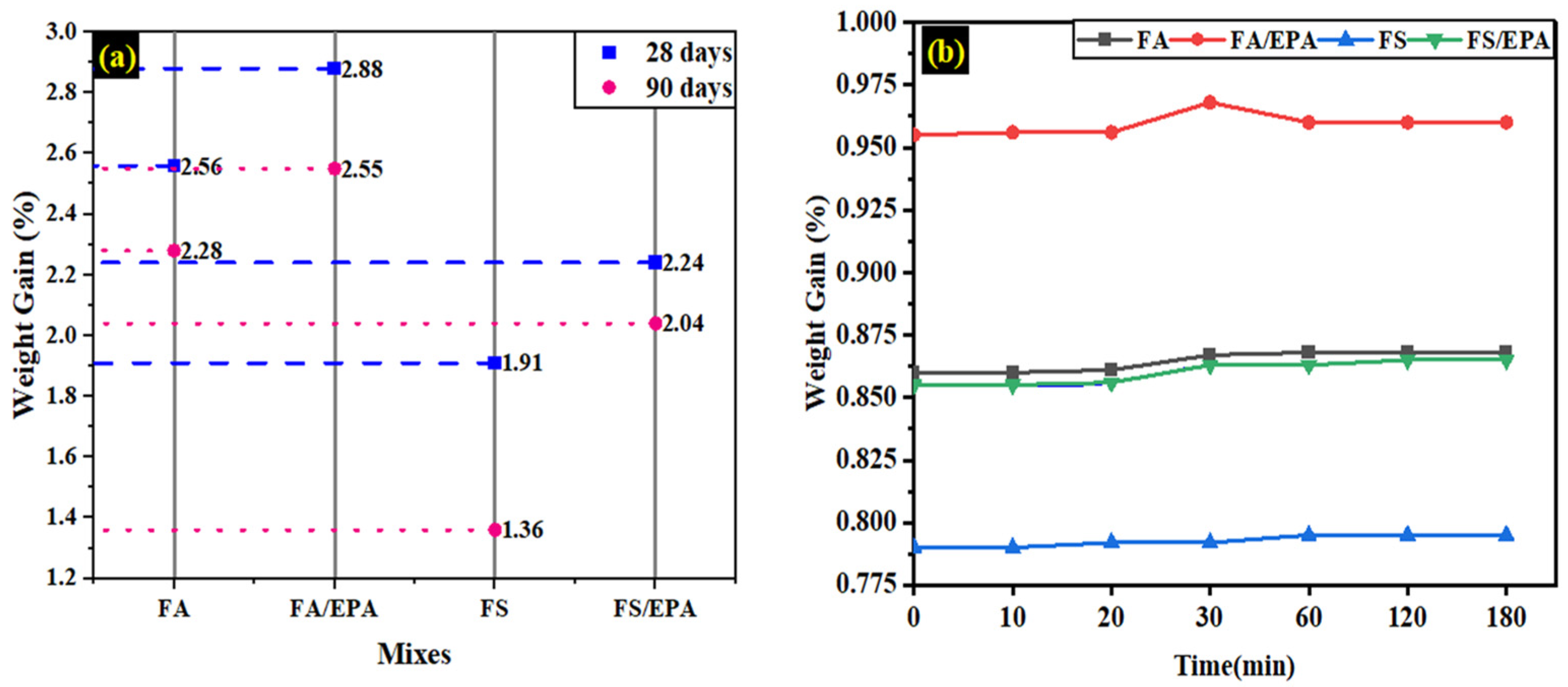


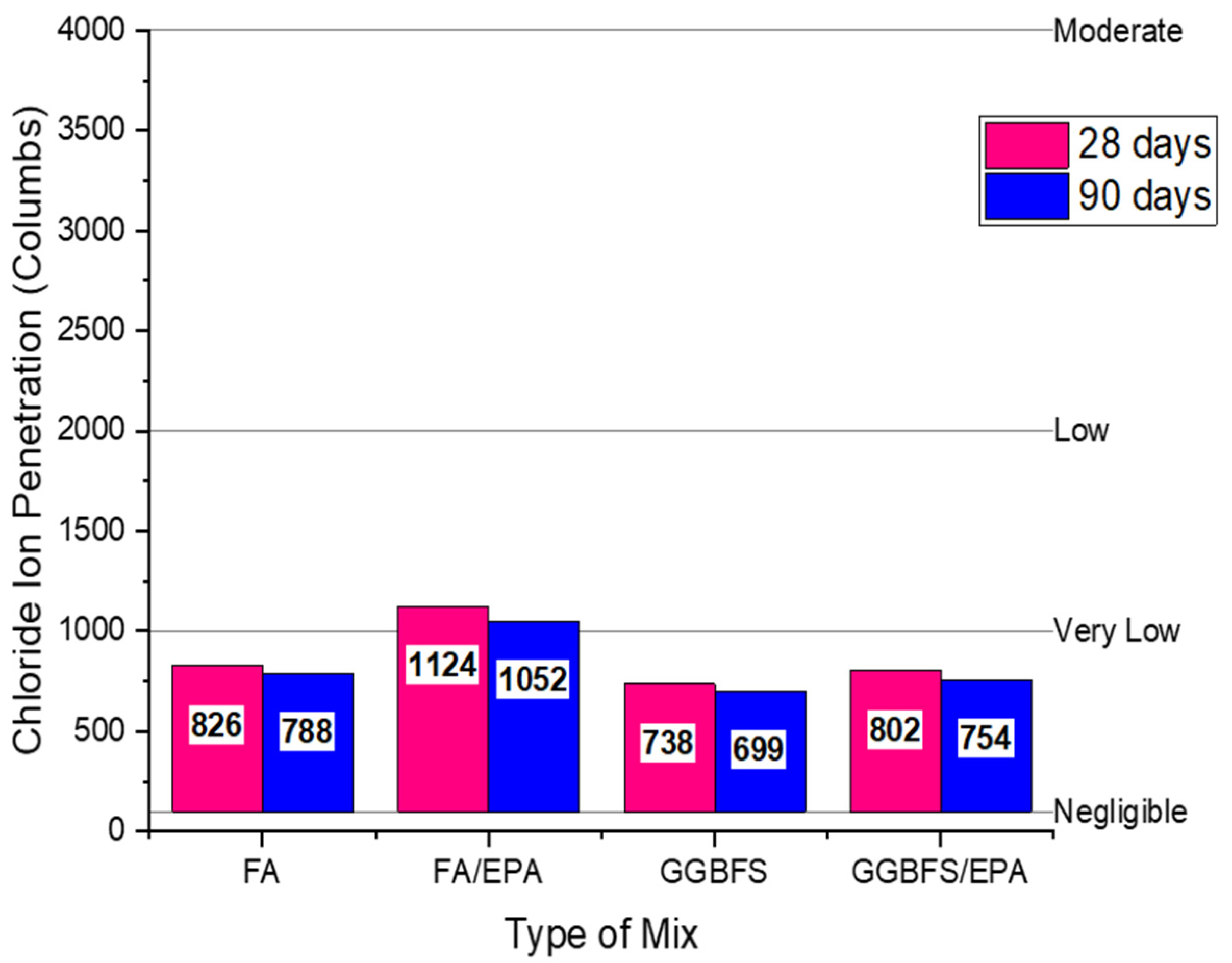
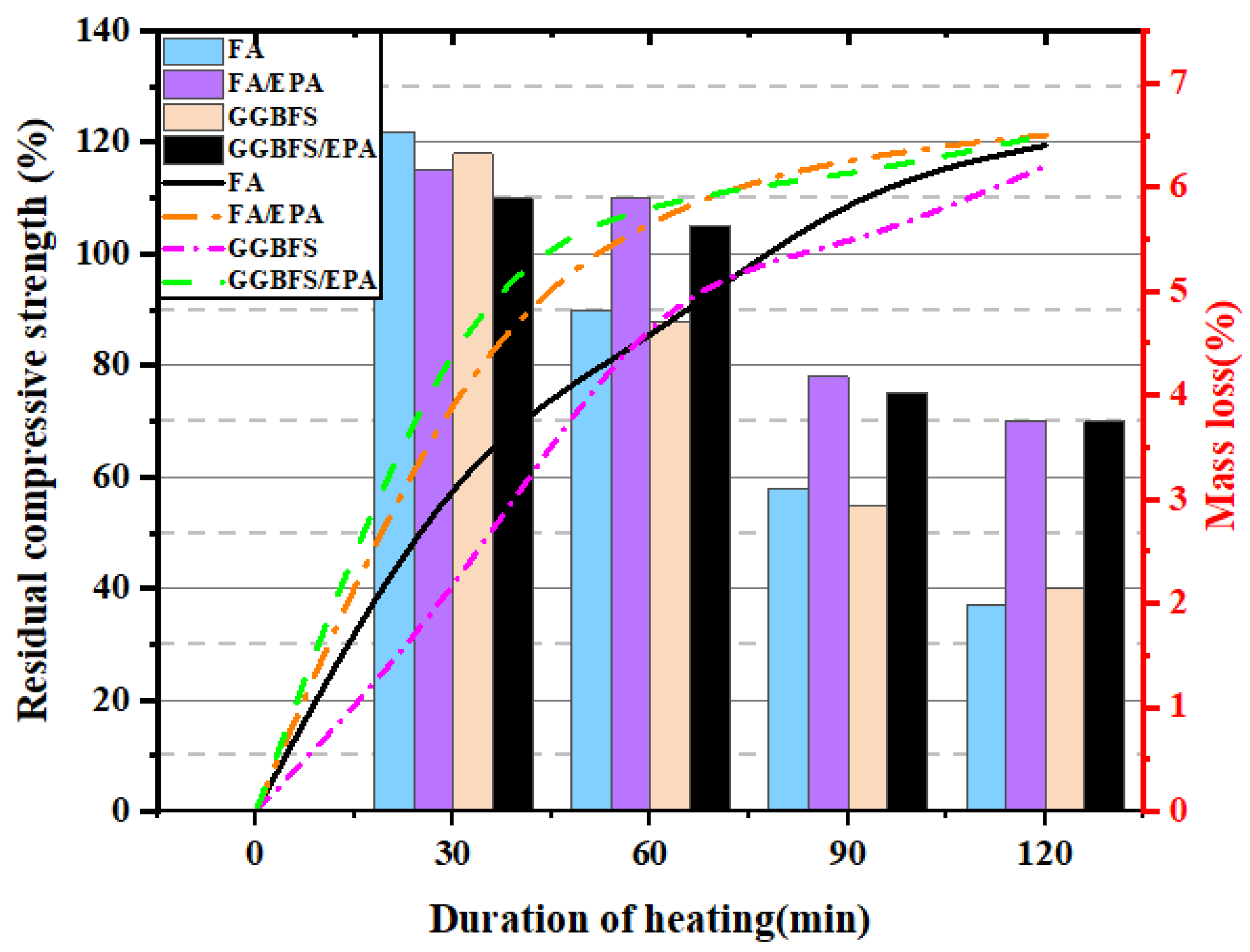
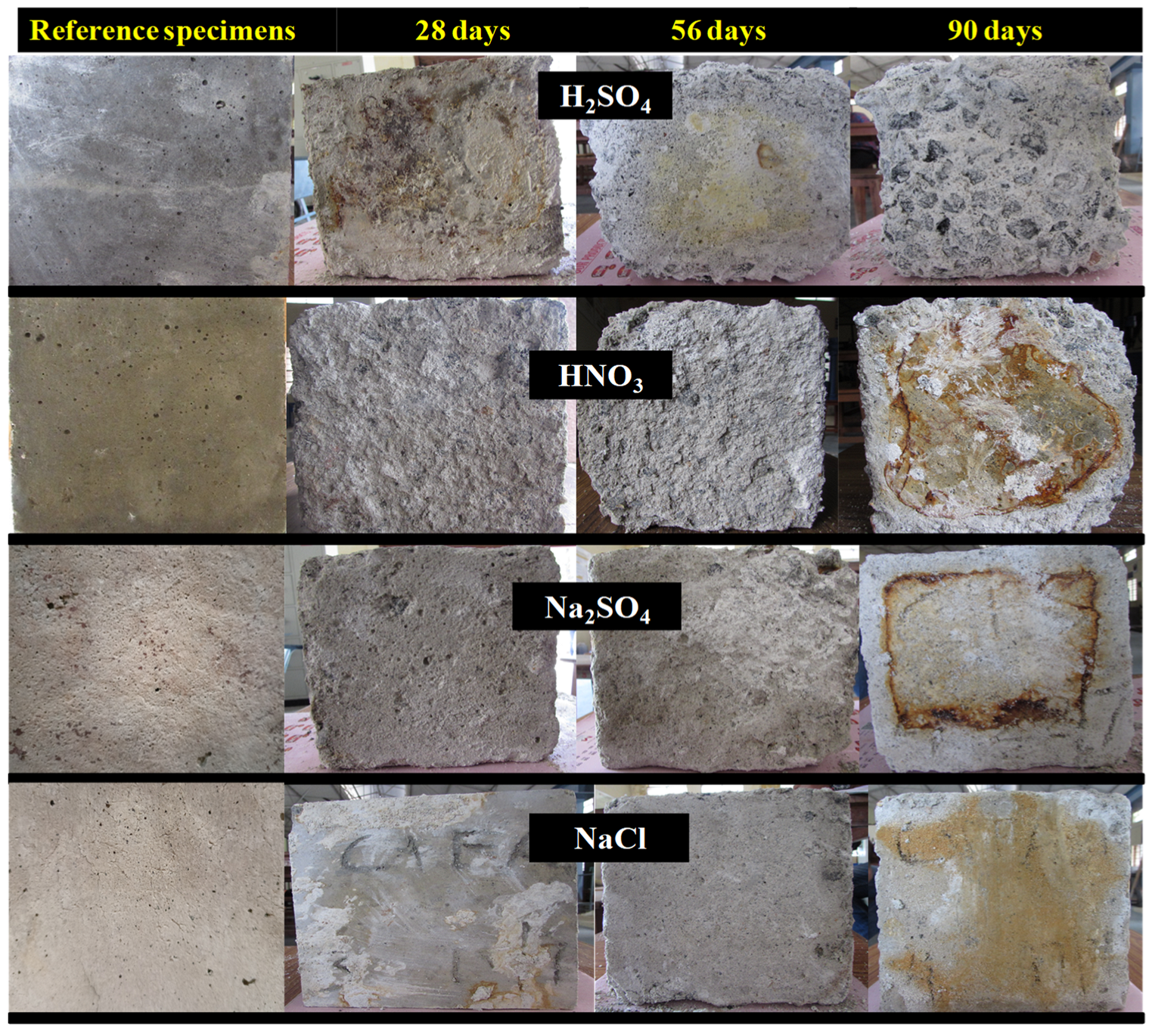
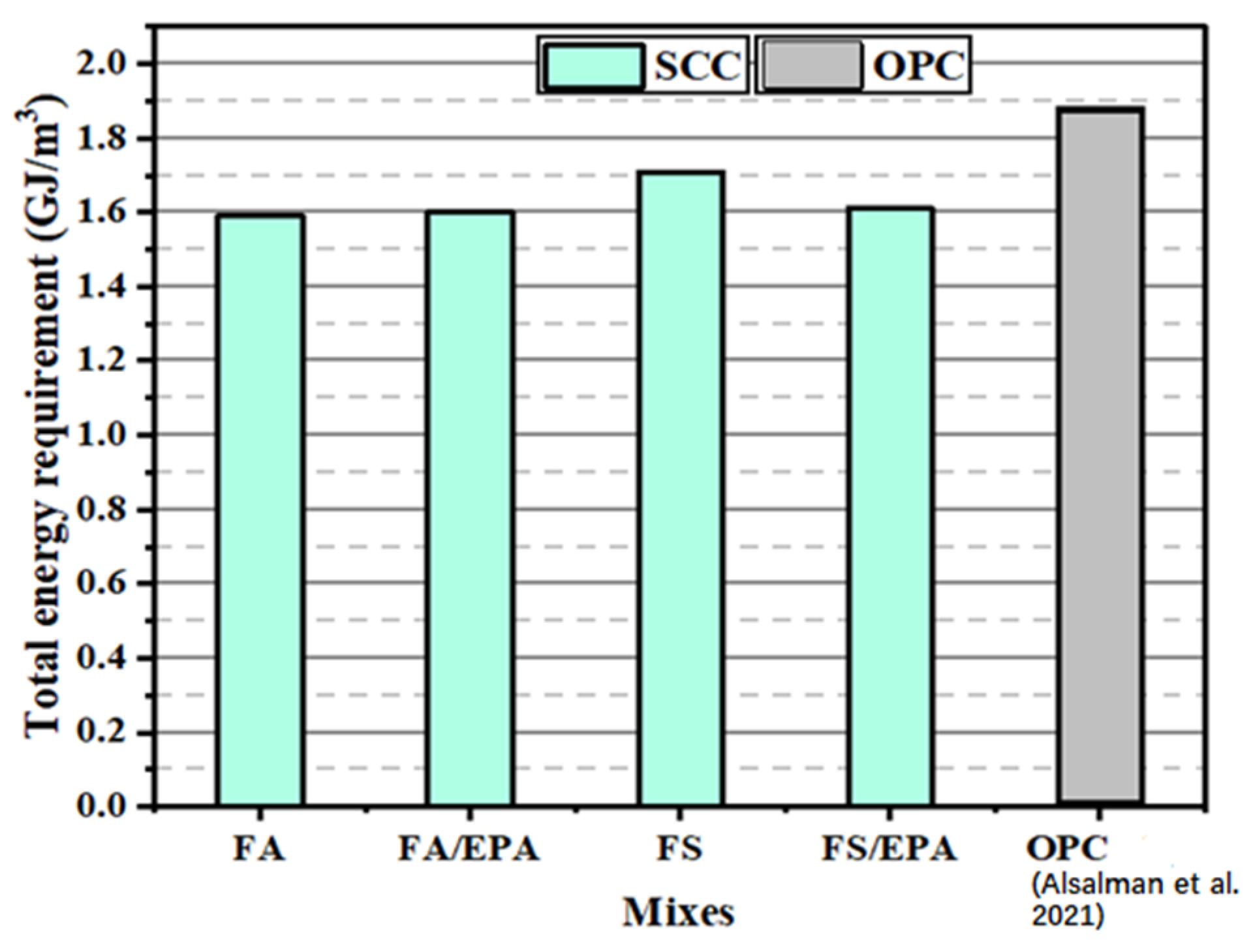

| Description | Chemical Composition (%) | |||
|---|---|---|---|---|
| OPC | FA | GGBFS | EPA | |
| SiO2 | 20.12 | 58.50 | 37.72 | 73.5 |
| Fe2O3 | 3.41 | 3.42 | 1.12 | 1.21 |
| Al2O3 | 8.53 | 28.24 | 14.43 | 8.56 |
| CaO | 61.31 | 4.96 | 37.35 | 0.92 |
| MgO | 2.26 | 0.31 | 8.12 | 1.12 |
| Na2O | 1.81 | 0.55 | 0.17 | 2.86 |
| K2O | 2.21 | 1.27 | 0.92 | 5.6 |
| SO3 | 0.24 | 2.25 | 0.26 | 6.2 |
| Loss of ignition | 0.05 | 0.02 | 0.01 | 0.025 |
| Description | Physical Properties | |||
| OPC | FA | GGBFS | EPA | |
| Specific gravity | 3.15 | 2.38 | 2.45 | 2.12 |
| Density(kg/m3) | 3200 | 1580 | 1786 | 675 |
| Surface area(m2/kg) | 3310 | 892 | 1200 | - |
| Colour | Pale grey | Light grey | Whitish | White |
| Material | Density (kg/m3) | Specific Gravity | WA |
|---|---|---|---|
| Manufactured sand | 1624 | 2.73 | 0.59 |
| Coarse aggregate | 1792 | 2.82 | 0.46 |
| Mix No. | SCC Mix Proportions (kg/m3) | |||||||||
|---|---|---|---|---|---|---|---|---|---|---|
| OPC | w/p * | SP | VMA | Water | FA | GGBFS | EPA | Aggregates | ||
| Coarse Aggregate | Manufacture Sand | |||||||||
| 1 * | 320 | 0.42 | 0.8 | 0.10 | 218 | 144 | - | - | 804 | 963 |
| 2 * | 320 | 0.42 | 0.9 | 0.15 | 218 | 144 | - | 24 | 804 | 939 |
| 3 * | 320 | 0.42 | 0.9 | 0.15 | 218 | - | 144 | - | 804 | 963 |
| 4 * | 320 | 0.42 | 1 | 0.20 | 218 | - | 144 | 24 | 804 | 939 |
| Workability Tests | Fresh State Properties | |||||
|---|---|---|---|---|---|---|
| Mix 1 | Mix 2 | Mix 3 | Mix 4 | EFNARC Permissible Limits | ||
| Minimum | Maximum | |||||
| Slump Flow (mm) | 660 | 665 | 675 | 680 | 640 | 800 (SF 2) |
| T500Flow Time (sec) | 2.90 | 2.73 | 2.45 | 2.20 | >2 (VF 2) | |
| J-Ring (mm) | 7.00 | 6.60 | 6.20 | 6.00 | 0 | 10 |
| V-Funnel (sec) | 10.80 | 10.40 | 11.70 | 11.30 | ≥7 to ≤27 (VF 2) | |
| * Material | Cost (USD/MT) | SCC [Present Investigation Mixes] | OPC | ||||||||
|---|---|---|---|---|---|---|---|---|---|---|---|
| Mix-1 | Mix-2 | Mix-3 | Mix-4 | ||||||||
| * Qty /m3 | Cost /m3 | Qty /m3 | Cost /m3 | Qty /m3 | Cost /m3 | Qty /m3 | Cost /m3 | Qty /m3 | Cost /m3 | ||
| OPC | 102.11 | 320 | 32.6 | 320 | 32.67 | 320 | 32.67 | 320 | 32.67 | 383 | 39.10 |
| FA | 12.15 | 144 | 1.74 | 144 | 1.74 | NA | NA | NA | NA | 801 | 5.83 |
| GGBFS | 67.52 | NA | NA | NA | NA | 144 | 9.72 | 144 | 9.72 | NA | |
| EPA | 4.11 | NA | NA | 24 | 0.09 | NA | NA | 24 | 0.09 | NA | |
| MS | 7.28 | 963 | 7.01 | 939 | 6.83 | 963 | 7.01 | 939 | 7.01 | NA | |
| CA | 9.45 | 804 | 7.59 | 804 | 7.59 | 804 | 7.59 | 804 | 7.59 | 1041 | 10.37 |
| SP | 3812 | 0.8 | 0.20 | 0.8 | 0.20 | 0.8 | 0.20 | 0.8 | 0.20 | NA | |
| VMA | 2912 | 0.1 | 0.03 | 0.1 | 0.03 | 0.1 | 0.03 | 0.1 | 0.03 | NA | |
| Total cost | 49.2 | 49.2 | 57.2 | 57.3 | 55.3 | ||||||
| CS | 35 | 33 | 37 | 36 | 32 | ||||||
| CE | 0.71 | 0.67 | 0.64 | 0.62 | 0.54 | ||||||
Disclaimer/Publisher’s Note: The statements, opinions and data contained in all publications are solely those of the individual author(s) and contributor(s) and not of MDPI and/or the editor(s). MDPI and/or the editor(s) disclaim responsibility for any injury to people or property resulting from any ideas, methods, instructions or products referred to in the content. |
© 2023 by the authors. Licensee MDPI, Basel, Switzerland. This article is an open access article distributed under the terms and conditions of the Creative Commons Attribution (CC BY) license (https://creativecommons.org/licenses/by/4.0/).
Share and Cite
Mathews, M.E.; Kiran, T.; Nammalvar, A.; Anbarasu, M.; Kanagaraj, B.; Andrushia, D. Evaluation of the Rheological and Durability Performance of Sustainable Self-Compacting Concrete. Sustainability 2023, 15, 4212. https://doi.org/10.3390/su15054212
Mathews ME, Kiran T, Nammalvar A, Anbarasu M, Kanagaraj B, Andrushia D. Evaluation of the Rheological and Durability Performance of Sustainable Self-Compacting Concrete. Sustainability. 2023; 15(5):4212. https://doi.org/10.3390/su15054212
Chicago/Turabian StyleMathews, Mervin Ealiyas, Tattukolla Kiran, Anand Nammalvar, M. Anbarasu, Balamurali Kanagaraj, and Diana Andrushia. 2023. "Evaluation of the Rheological and Durability Performance of Sustainable Self-Compacting Concrete" Sustainability 15, no. 5: 4212. https://doi.org/10.3390/su15054212






